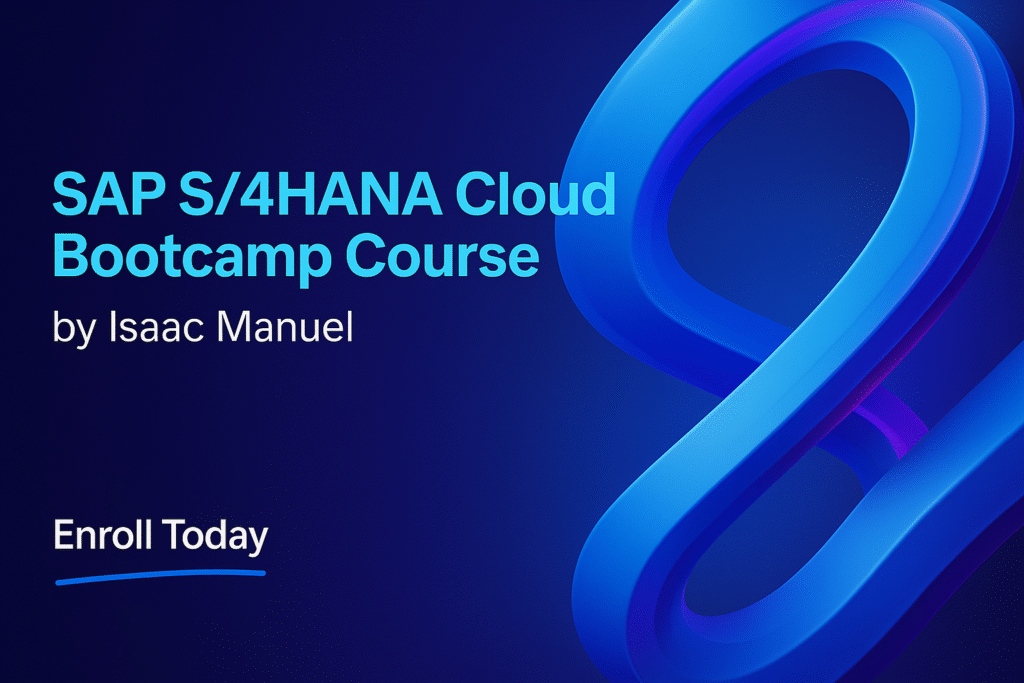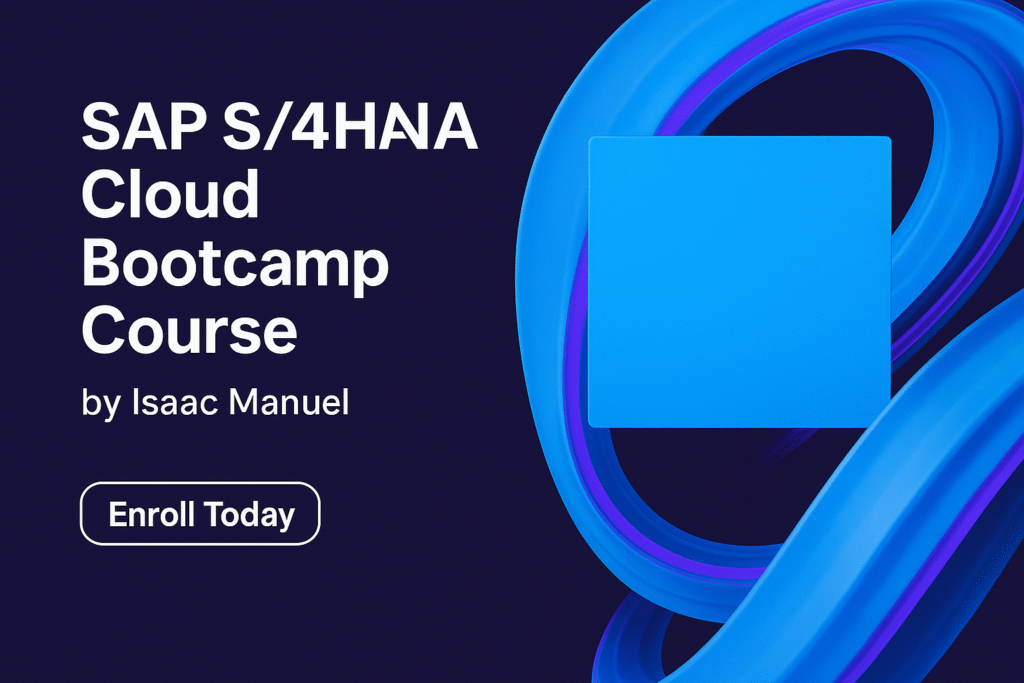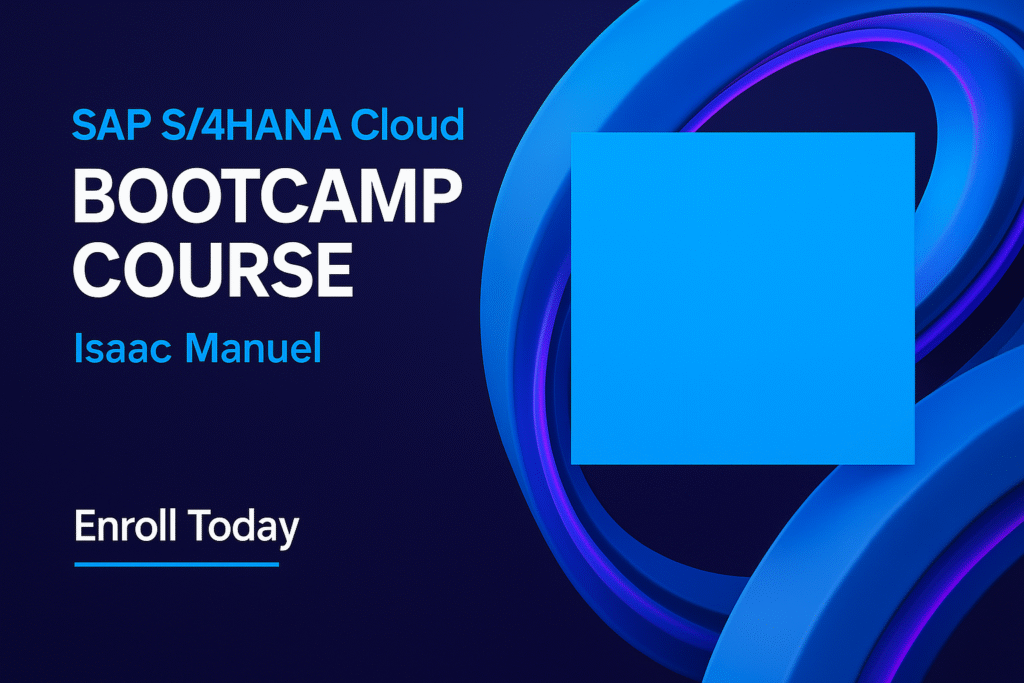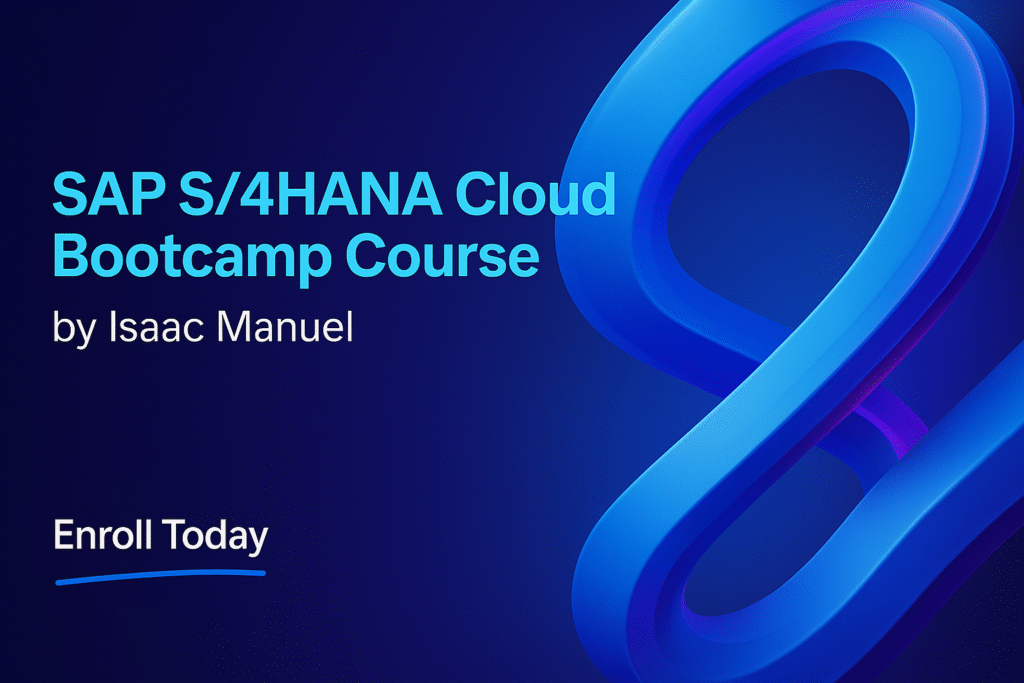SAP S/4HANA Cloud has rapidly become a cornerstone of modern enterprise technology, offering powerful tools for finance, operations, supply chain, and more. If you’re a complete beginner or a seasoned professional transitioning into the SAP world, learning S/4HANA Cloud in 2025 can open up exciting career opportunities. This expert guide provides a friendly, step-by-step roadmap to help you master SAP S/4HANA Cloud from scratch. We’ll explore why it’s worth learning now, explain what S/4HANA Cloud is, discuss how long it might take to learn, outline a plan to get you started, point you to top resources (including an excellent course by Isaac Manuel), and wrap up with some final thoughts.
Let’s dive into the most effective methods, resources, and tools to become proficient in SAP S/4HANA Cloud – even if you have no prior SAP experience.
Why Learn SAP S/4HANA Cloud in 2025?
Before embarking on your learning journey, it’s important to know why SAP S/4HANA Cloud is such a valuable skill in 2025. Here are some key reasons to consider:

-
High Industry Demand: A majority of large enterprises are in the process of moving to SAP S/4HANA. In fact, over 70% of large companies plan to migrate to S/4HANA by 2026. With SAP ending support for older ERP systems (SAP ECC) by 2027, there’s a surge in demand for professionals skilled in S/4HANA Cloud to guide these migrations. Learning S/4HANA now positions you for these in-demand roles.
-
Modern, Future-Proof Skills: S/4HANA Cloud is built on cutting-edge technology (like the in-memory SAP HANA database) and comes with AI-driven insights and real-time analytics. It’s SAP’s next-generation cloud ERP designed for the digital age. By learning it, you gain future-proof skills that keep you relevant as businesses embrace cloud-based, intelligent systems.
-
Global Career Opportunities: SAP is used by organizations worldwide, from enterprises to fast-growing startups. Even tech giants leverage SAP’s ERP solution, which shows how pervasive SAP is across industries. S/4HANA Cloud expertise can unlock career opportunities globally in industries like manufacturing, finance, healthcare, retail, and more.
-
Improved Business Outcomes: Companies adopt S/4HANA Cloud to gain agility, efficiency, and better decision-making. By understanding S/4HANA Cloud, you can help businesses simplify complex processes (thanks to S/4HANA’s simplified data model) and drive innovation. This means SAP professionals often play strategic roles in improving business processes and digital transformation.
-
Accessible Learning Ecosystem: Unlike the old days where learning SAP required expensive in-person training, today there are many beginner-friendly resources. SAP provides free learning programs, community forums, and trials, so even newcomers can start learning at their own pace. In 2025, it’s easier than ever to find tutorials, courses, and sandbox environments to practice, making the learning curve more manageable.
With technology rapidly evolving and many companies racing to upgrade their systems, learning SAP S/4HANA Cloud in 2025 is a timely decision that can secure and advance your career.
What Is SAP S/4HANA Cloud?
SAP S/4HANA Cloud is SAP’s next-generation cloud-based ERP (Enterprise Resource Planning) system. In simpler terms, it’s a comprehensive business software suite that companies use to manage everything from finances and accounting to supply chain, sales, procurement, and human resources – all in the cloud. It builds on the legacy of SAP’s earlier ERP products but with modern innovations:
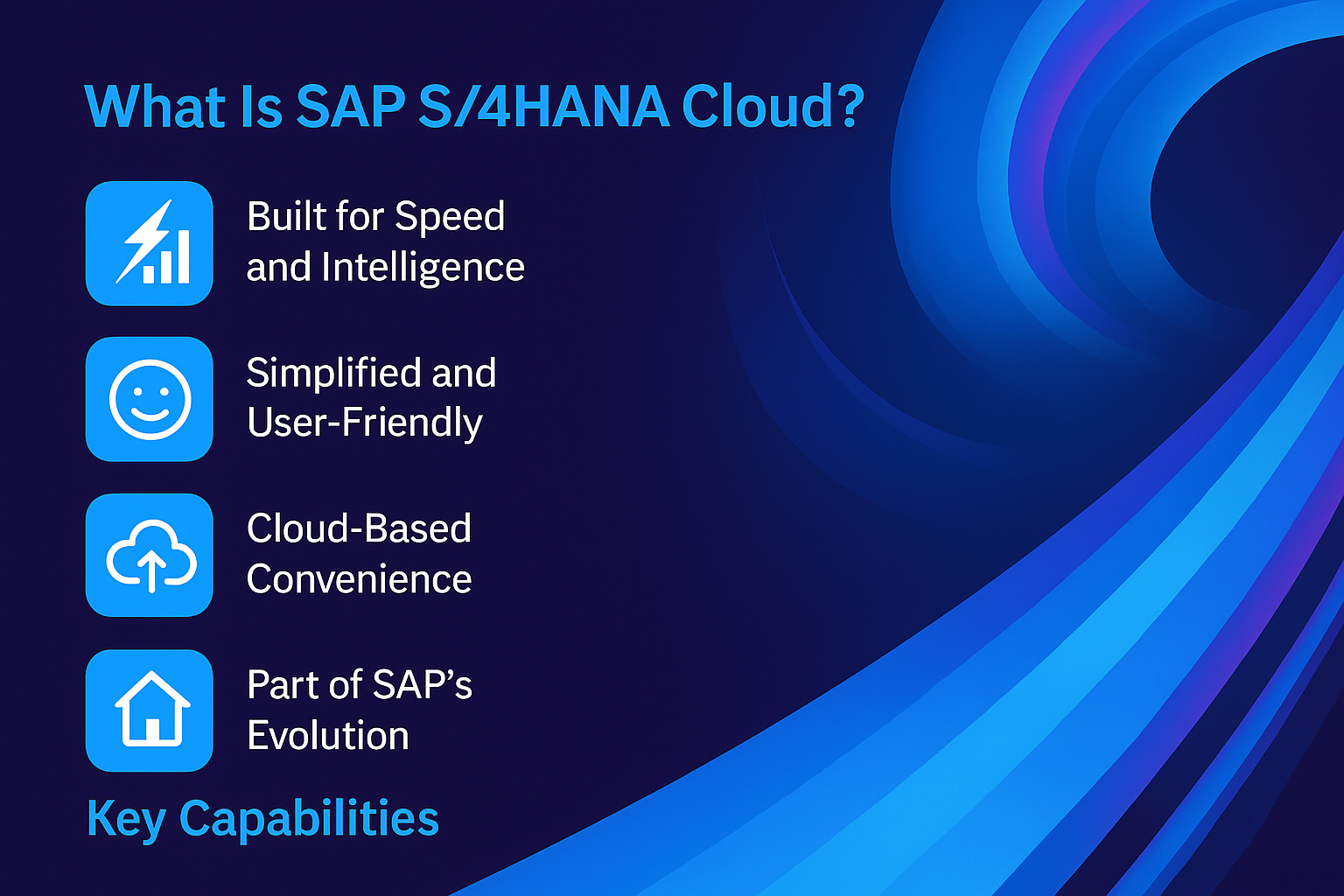
-
Built for Speed and Intelligence: S/4HANA Cloud runs on the SAP HANA database, an in-memory database that allows lightning-fast processing and real-time analytics. This means businesses can analyze data and get insights immediately, without waiting for overnight batch jobs as in older systems.
-
Simplified and User-Friendly: The architecture of S/4HANA is simplified compared to previous SAP ERP versions. It eliminates many old complexities and data redundancies by centralizing information into a single source of truth. The user interface is also modern – S/4HANA Cloud uses SAP Fiori, a sleek, app-like interface that users can access through a web browser on any device, making it much more intuitive than the old SAP GUI.
-
Cloud-Based Convenience: As a cloud SaaS (Software-as-a-Service) solution, S/4HANA Cloud is hosted by SAP and updated quarterly with new features. Businesses don’t have to maintain heavy infrastructure; they can subscribe to the service and always run the latest version. This cloud model gives companies agility and faster innovation cycles. (There are both public and private cloud editions, but the key is that the system is managed in the cloud rather than installed on individual company servers.)
-
Part of SAP’s Evolution: SAP S/4HANA Cloud is the product of decades of SAP’s ERP evolution. (To appreciate how we got here, see the lesson on Evolution and History of SAP for a deep dive.) In brief, SAP’s journey started with mainframe-based software in the 1970s, moved through client-server systems in the 90s (SAP R/3), then to SAP ERP/ECC in the 2000s, and finally to S/4HANA in 2015. S/4HANA Cloud, introduced after 2015, brings that core ERP into a cloud environment, addressing modern challenges like big data, IoT integration, and mobile accessibility. It’s a modern era for SAP, designed to meet today’s business needs with continuous updates and innovations.
-
Key Capabilities: SAP S/4HANA Cloud covers all the essential business processes (finance, sales, procurement, manufacturing, project management, etc.) with built-in best practices. It also has embedded analytics, machine learning scenarios, and integrations to other SAP products (like SuccessFactors for HR or Ariba for procurement). For a company, adopting S/4HANA Cloud can lead to faster and smarter processes, a better user experience for employees, and regular access to new features and improvements.
In short, SAP S/4HANA Cloud is a powerful, cloud-based ERP system that helps companies run smarter. As an aspiring learner, understanding S/4HANA Cloud means you’ll be learning how modern businesses organize and execute their day-to-day operations using one integrated system.
How Long Does It Take to Learn SAP S/4HANA Cloud?
One of the first questions many learners ask is, “How long will it take me to learn this?” The answer: it depends on your background, how deep you want to go, and the time you can dedicate. But let’s break down a general roadmap for learning SAP S/4HANA (the timeline can vary widely):
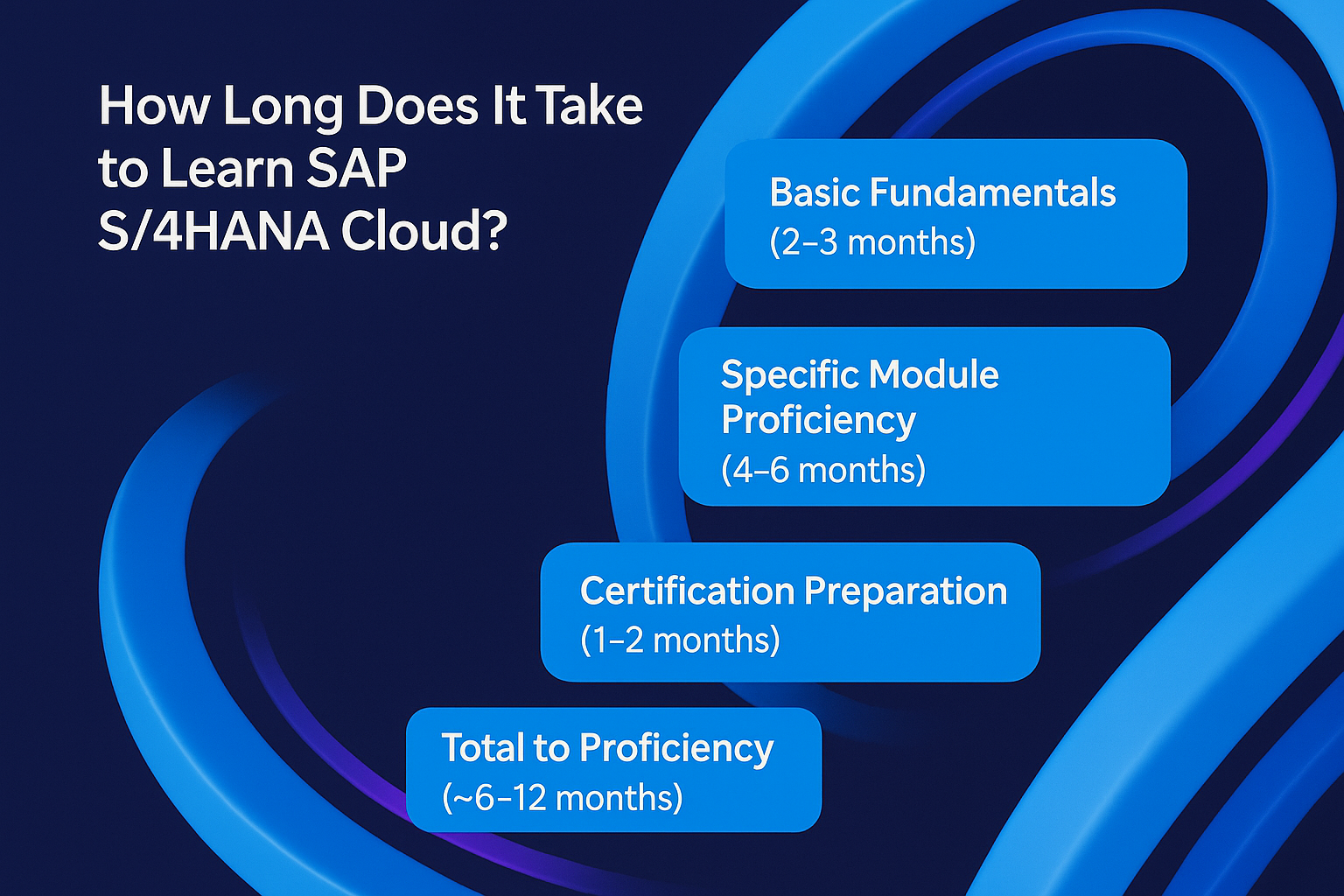
-
Basic Fundamentals (2–3 months): If you’re completely new to SAP or ERP systems, expect to spend a couple of months to grasp the fundamentals. In this stage, you’ll learn basic navigation, understand core concepts like what an ERP is, how SAP modules are structured, and get familiar with the S/4HANA Cloud interface (Fiori). Many beginners start with an introduction course or SAP’s own free tutorials during this period.
-
Specific Module Proficiency (4–6 months): Once you have the basics, you might focus on a particular area (for example, Financial Accounting, or Sales & Distribution, or SAP Logistics). Gaining solid skills in one module or domain of S/4HANA can take several more months of study and practice. Typically, a focused learning path for a module – including doing exercises or a project – might take on the order of 4 to 6 months. For instance, if you aim to become proficient in SAP S/4HANA Finance, some training providers estimate a few months of training and practice (around 40–60 hours of coursework plus hands-on practice) to be job-ready in that module.
-
Certification Preparation (1–2 months): If you plan to get an official SAP certification, you’ll need additional time to prepare for the exam. SAP certifications (e.g., SAP Certified Application Associate for S/4HANA Cloud) usually require you to review all topics, do practice exams, and solidify your knowledge. Learners often allocate another couple of months for dedicated exam prep.
-
Total to Proficiency (~6–12 months): In total, reaching a level where you can confidently work with SAP S/4HANA Cloud in a professional setting might take around half a year to a year of consistent learning. This assumes you’re putting in regular effort (say, a few hours most days or a dedicated chunk per week). If you have prior experience with ERP systems or programming, you might progress faster; if you’re brand new or learning part-time, it could take longer.
-
Ongoing Learning: Even after 6-12 months, learning SAP is an ongoing journey. The software is continuously updated (new features every quarter in the cloud!), and there are many advanced topics (like deeper configuration, extensibility on SAP BTP, or advanced analytics) that you can tackle over time. Many SAP professionals will tell you they keep learning new things throughout their careers. So, think of your first year as getting a strong foundation – after that, you’ll continue to build expertise while on the job or through further study.
The good news: you don’t need to master everything to start getting value from your knowledge. Even after a couple of months, you might be able to navigate the system, run basic transactions, and contribute in an SAP project in a junior role. From there, every additional skill you learn (like how to configure a process or write a simple report) will increase your capabilities.
Remember, everyone’s pace is different. The key is consistency and practical practice. Next, we’ll outline a step-by-step plan to guide your learning process, which can help make your learning efficient and effective.
How to Learn SAP S/4HANA Cloud in 2025 (Step-by-Step Plan)
Learning SAP S/4HANA Cloud might feel like a daunting task given the breadth of the system, but breaking it into clear steps will make the journey much smoother. Here’s a step-by-step plan you can follow in 2025:
1. Set Clear Goals and Choose Your Path
Before you write a single line in SAP or watch a tutorial, clarify why and what you want to learn in S/4HANA Cloud. SAP is a broad field – having a direction will focus your efforts:
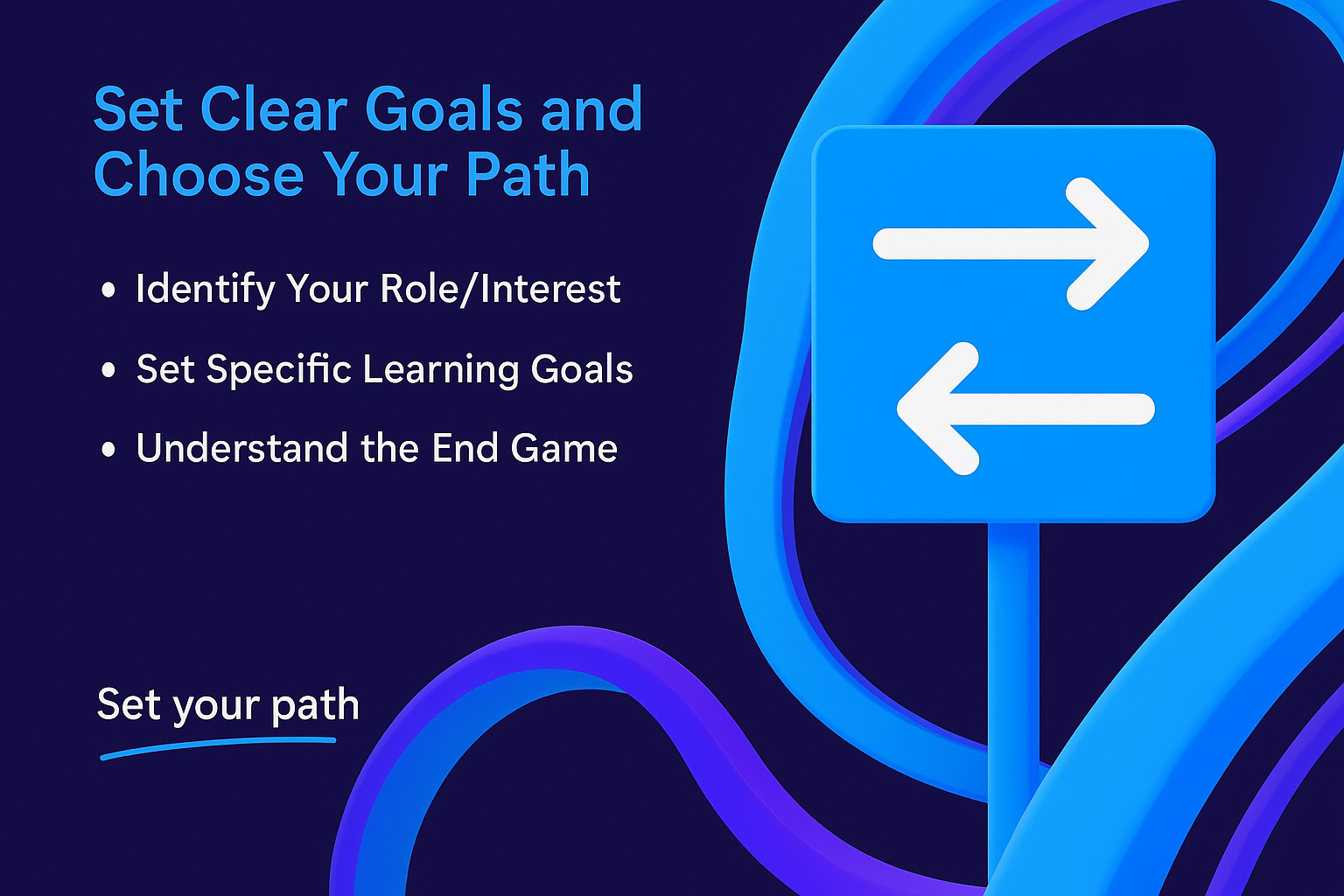
-
Identify Your Role/Interest: Do you want to be a functional consultant who focuses on business processes (e.g., finance, logistics, HR), or a technical consultant/developer who works on programming and system setup? For example, a functional consultant might specialize in modules like Finance (FI) or Materials Management (MM), while a technical path might involve learning ABAP programming, SAP Fiori UI development, or integration tools. Deciding this early on will determine which topics you should prioritize.
-
Set Specific Learning Goals: Maybe your goal is “I want to become an SAP S/4HANA Cloud Finance consultant within a year,” or “I want to learn how to configure a sales process in S/4HANA,” or even “I just want to understand SAP to improve my business operations.” Write down your goals. Clear goals will keep you motivated and guide you in choosing the right learning materials.
-
Understand the End Game: If your aim is a job or certification, research the requirements. For instance, look up job postings for “SAP S/4HANA consultant” to see what skills employers expect (which modules, what experience). Or check the syllabus of SAP certification exams to know which topics to cover. This will give you a checklist of things to learn.
By setting a direction (e.g., “I will focus on S/4HANA Cloud Finance module and aim to pass the SAP Finance certification”), you turn a huge learning project into a series of manageable targets.
2. Understand ERP Basics and SAP Fundamentals
Next, build your foundation. If you’re new to enterprise software, start with the basics of ERP and SAP:
-
Learn What ERP Means: ERP (Enterprise Resource Planning) is the category of software SAP belongs to. It integrates core business processes into one system. Spend some time learning how typical business processes work (like order-to-cash, procure-to-pay, record-to-report for finance) and how an ERP system manages these. This conceptual understanding will make the detailed SAP stuff much easier to grasp.
-
Get to Know SAP’s History and Structure: Understanding SAP’s background can give you context. SAP has been a leader in ERP for decades, evolving through various product generations (R/3, ECC, now S/4HANA). Knowing this evolution helps you appreciate the why behind S/4HANA Cloud’s design. (For a quick overview, you might check out the lesson on the Evolution and History of SAP – it covers SAP’s journey from its founding in 1972 up to S/4HANA Cloud, highlighting key innovations along the way.)
-
Familiarize Yourself with S/4HANA Cloud Basics: This includes learning about the SAP module structure and the user interface. SAP S/4HANA is modular – for example, Finance (FI), Sales (SD), Materials Management (MM), Human Capital Management (HCM), etc., each covering a business area. Get a high-level understanding of what each major module does. Also, learn how to navigate the SAP Fiori Launchpad (the home screen with tiles for apps) and basic tasks like searching for an app, running a report, etc., in S/4HANA Cloud.
-
Use Beginner-Friendly Resources: At this stage, consider enrolling in an introductory course or reading SAP’s own beginner guides. Many courses start by explaining ERP concepts and SAP’s core ideas. For instance, the Getting Started with SAP S/4HANA Cloud course by Isaac Manuel begins with ERP fundamentals and SAP’s evolution, which helps you quickly grasp the context and advantages of S/4HANA Cloud. You can also find free overviews on SAP’s Learning site or YouTube that answer “What is S/4HANA?” in simple terms.
By the end of this step, you should understand what SAP S/4HANA Cloud is, the problems it solves, and have a mental map of its components. You don’t need deep knowledge yet – think of this as learning the “alphabet” before writing sentences.
3. Take a Structured Course or Learning Program
Self-study is important, but a structured learning program can dramatically speed up your progress. Rather than trying to piece together random tutorials, follow a well-designed course or learning path:
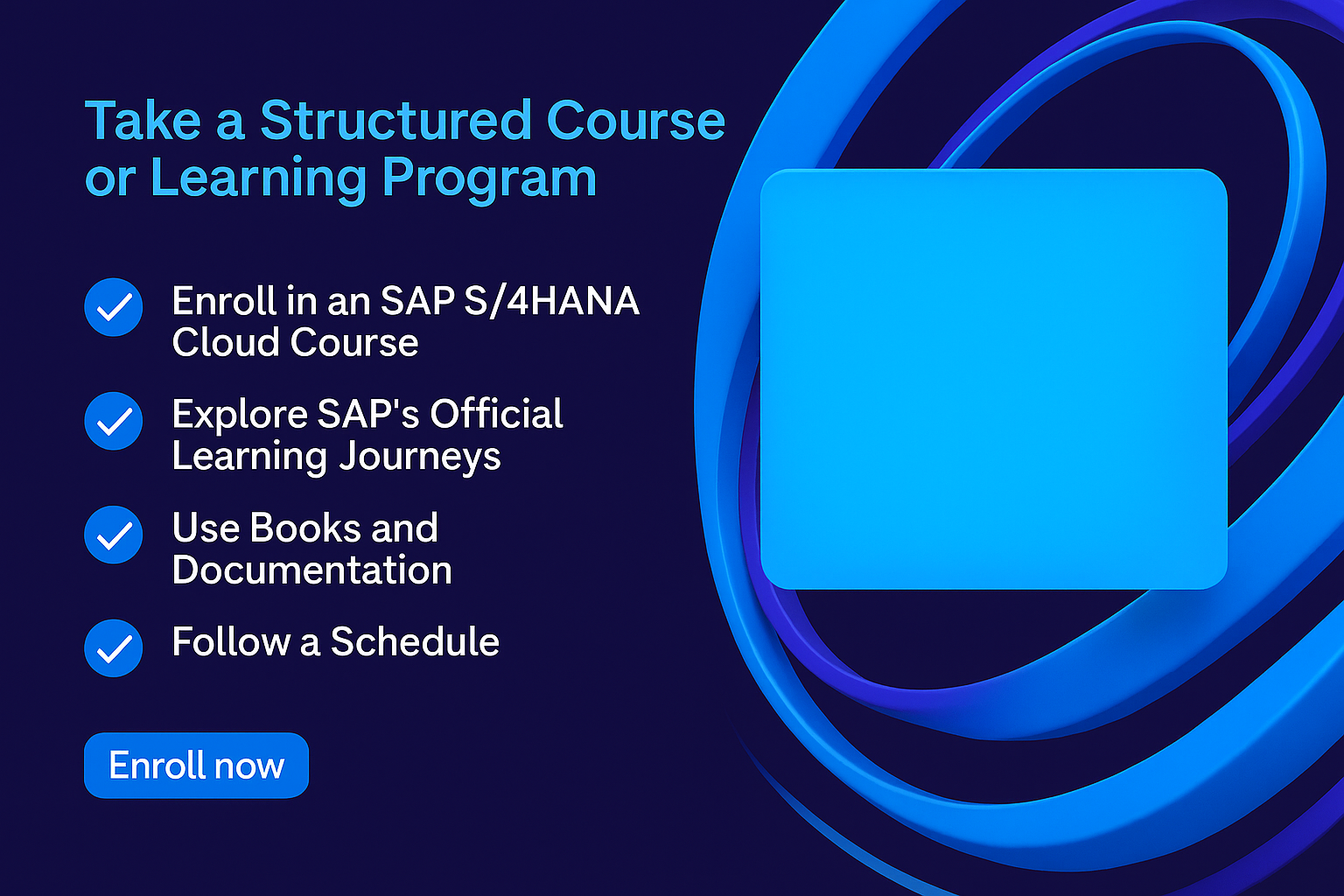
-
Enroll in an SAP S/4HANA Cloud Course: A good course will take you from zero to hero in a logical sequence – starting with basics, then gradually introducing more complex topics with practice. For example, the course by Isaac Manuel offers hands-on, beginner-friendly training, guiding you step-by-step through essential S/4HANA Cloud skills. It’s designed for newcomers and covers everything from ERP fundamentals to practical scenarios, giving you a clear learning roadmap.
-
Explore SAP’s Official Learning Journeys: SAP provides Learning Journeys (free online learning paths) on their website. These are like interactive guides that recommend what courses, tutorials, or documents to go through for a given topic or role. For S/4HANA Cloud, there are learning journeys for different roles (e.g., Business User, Implementation Consultant, Developer). They often include a mix of videos, readings, and hands-on exercises. The content formerly on openSAP (SAP’s MOOC platform) has now moved to the main SAP Learning site – there are over 100 free courses from SAP experts available. Take advantage of these; they’re a goldmine of up-to-date information.
-
Use Books and Documentation: If you prefer reading, consider SAP Press books or the official SAP Help Portal documentation. SAP Press has titles like “SAP S/4HANA Cloud for Beginners” or module-specific guides which can be great references. The SAP Help Portal (help.sap.com) has free documentation for every part of S/4HANA – though it’s very detailed, so it’s more useful when you need to deep dive into a specific question.
-
Follow a Schedule: Since these courses are often self-paced, make a schedule for yourself. For example, commit to completing one module of an online course per week. Treat it like a class: take notes, do the exercises, and ensure you understand each section before moving on. If the course provides quizzes or hands-on assignments, do them diligently as they solidify your knowledge.
A structured course gives you a curated pathway so you don’t feel lost. It ensures you cover all fundamental topics in order. By the end of a good training program, you should have a broad understanding of S/4HANA Cloud and even some specific skills you can apply.
4. Practice Hands-On in a Sandbox Environment
Hands-on practice is where you truly start to absorb how SAP S/4HANA Cloud works. Reading and watching can only take you so far – you need to click the buttons, run the transactions, and see things in action:
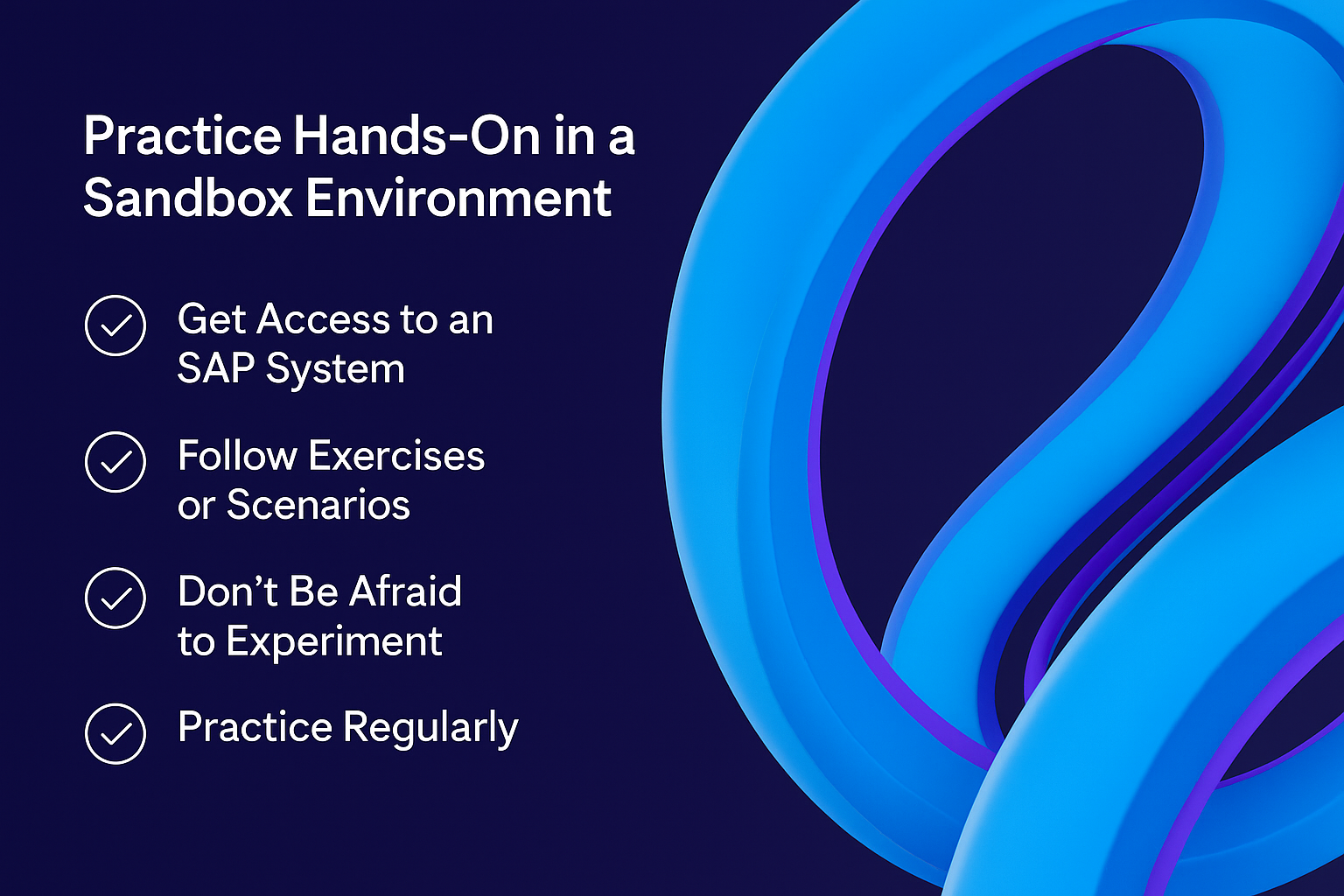
-
Get Access to an SAP System: This is one of the trickier parts for newcomers, since SAP S/4HANA Cloud isn’t software you can just install on your laptop. However, there are a few ways to get practice access. SAP occasionally offers trial systems or sandbox environments for learning purposes. For example, you might get a 14-day trial of S/4HANA or use SAP’s IDES (a demo system with sample data). Another option is to sign up for the SAP Learning Hub (professional edition) which provides access to training systems for practice (this is paid, though sometimes there are free community editions for students). Many learners also use cloud share services or join a course that provides system access.
-
Follow Exercises or Scenarios: Once you have access to a practice system, try out the things you learned in your course or tutorials. Start with simple tasks: e.g., create a customer record, post a journal entry in Finance, or create a sales order and see it flow to an invoice. By executing these steps in the system, you’ll understand how different modules link together. SAP often provides step-by-step tutorials for common scenarios (check the SAP Learning site or community blogs for “S/4HANA Cloud tutorial”).
-
Don’t Be Afraid to Experiment: The beauty of a sandbox is that you can’t break a real company’s data. So go ahead and explore the menus, click on apps, and see what each does. Try entering sample data (most demo systems come with preset company codes and records to play with). If you’re unsure how to do something, refer to the course or search for a guide on that specific process.
-
Practice Regularly: Consistency is key. Try to practice a bit every day or a few times a week. Even 30 minutes of logging into the system and navigating around can help reinforce your learning. Over time, things that felt confusing will become second nature (“Oh, I need to open the Manage Sales Orders app to do X” or “To view a financial statement, I go to Y app”). Regular hands-on practice is the fastest way to build confidence.
This step is where you turn knowledge into skill. It’s one thing to read about how a process works, and quite another to actually execute it in SAP. By practicing, you’ll also generate plenty of questions – which is great, because it means you’re identifying what you need to learn more deeply (and you can then research or ask about those questions).
5. Dive Deeper into Key Modules and Features
By now, you have a general understanding and some hands-on experience. Next, start diving deeper into the specific areas of S/4HANA Cloud that align with your goals:

-
Focus on Your Chosen Module(s): Earlier, you identified a path (functional or technical, and maybe a specific module). Now is the time to become really good at those. For example, if you chose Finance (FI), delve into the details of SAP S/4HANA Finance: learn about General Ledger, Accounts Payable, Accounts Receivable, Asset Accounting, etc. If you’re into Supply Chain, focus on Materials Management (MM) and Sales and Distribution (SD) processes – learn how procurement and inventory management works in S/4HANA Cloud. For technical folks, you might start learning ABAP coding for S/4HANA (on the SAP BTP ABAP environment) or how to create Fiori UI5 apps.
-
Learn the Integration Points: A big strength of SAP is how modules integrate. As you deep-dive, pay attention to how one process flows into another. For instance, a sales order in SD will create a demand that affects production (PP) and eventually accounting entries in FI. Understanding these connections not only helps you grasp the big picture, but is also crucial in real projects (where, say, a change in one area might impact another).
-
Use Advanced Learning Resources: For in-depth module learning, use more specialized resources. SAP’s Help guides are very detailed on specific configuration and processes. SAP Community forums and blogs are filled with how-tos and best practices for particular scenarios. You might also find YouTube tutorials or webinars focusing on, say, “Key features in S/4HANA Cloud Sales” or “Configuring Organizational Management in S/4HANA Cloud HCM”. If you have access to an SAP mentor or experienced colleague, now is a great time to ask them more complex questions.
-
Stay Updated on New Features: Since we’re in 2025, note that S/4HANA Cloud updates come frequently (every quarter). Keep an eye on “What’s New” documents from SAP for each release – they highlight new features or changes. This habit will keep you current. SAP’s official community and press releases often summarize the coolest new capabilities (like new AI-driven features or improved Fiori apps) introduced in each update.
This step is all about depth. It transforms you from someone who can “get around” in SAP to someone who understands how to use SAP S/4HANA Cloud to solve real business problems in your focus area. It also sets the stage for you to potentially become a specialist in that area.
6. Work on Real-World Projects or Simulations
Theory and isolated exercises are great, but real expertise comes from applying your skills to real-world scenarios. You might not have a job in SAP yet, but you can simulate or contribute to projects in various ways:
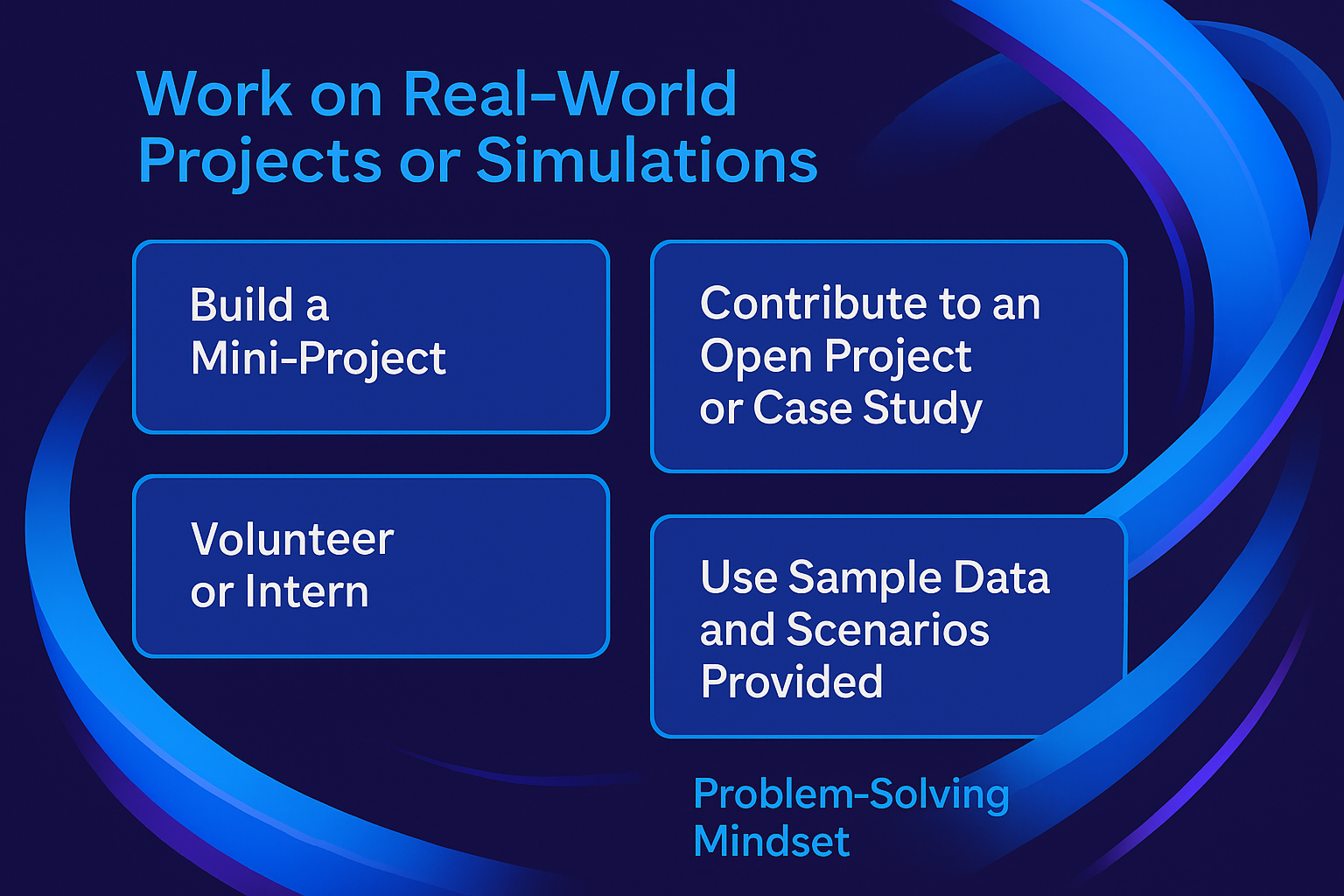
-
Build a Mini-Project: Think of a small project that mimics a business process, and try to execute it end-to-end in SAP. For example, create a scenario: “A company needs to sell 10 laptops.” In SAP, how would that happen? You’d create a customer, create a sales order for the laptops, deliver the product (outbound delivery), generate an invoice, and receive payment. Try to perform all those steps in your practice system. This kind of hands-on project ties together everything you’ve learned and highlights any gaps (maybe you realize you don’t know how to create a delivery document – then you go learn that).
-
Contribute to an Open Project or Case Study: Sometimes, communities or training programs have case studies or collaborative projects. For instance, an online course might have a capstone project like configuring a small company in S/4HANA Cloud. Participate in these if available. If you’re in a university or MBA program, see if there’s an ERP simulation class – those can be fun and educational.
-
Volunteer or Intern: If possible, seek opportunities to shadow or assist in an SAP project. Perhaps your current employer is implementing SAP – volunteer to be on the team or at least to test the system as a key user. If you can intern at a company or consulting firm that uses SAP, you’ll get exposure to real use cases (even if it’s just observing at first).
-
Use Sample Data and Scenarios Provided: SAP often provides best-practice scenarios with S/4HANA (especially in trial systems or in documentation). These are like guided examples of typical processes (e.g., how to process a customer return, or how to perform a financial closing task). Walk through these scenarios step by step. They are golden because they reflect how businesses actually use S/4HANA Cloud.
-
Problem-Solving Mindset: As you do projects, you’ll inevitably hit roadblocks or errors (e.g., missing configuration, authorization issues, etc.). This is normal! Use those challenges to deepen your learning. Research the errors, ask questions on forums, and figure out how to resolve them. This mimics real project work and builds your problem-solving skills in the SAP context.
Working on realistic scenarios will boost your confidence tremendously. It’s the difference between knowing the theory vs. knowing how to get things done in SAP. Plus, these project experiences are great stories to tell in interviews or on your resume/LinkedIn (e.g., “Configured a prototype order-to-cash process in an SAP S/4HANA Cloud demo environment”).
7. Join the SAP Community and Networking
You don’t have to learn SAP alone. There’s a vast, welcoming SAP community out there – tapping into it can accelerate your learning and make it more enjoyable:
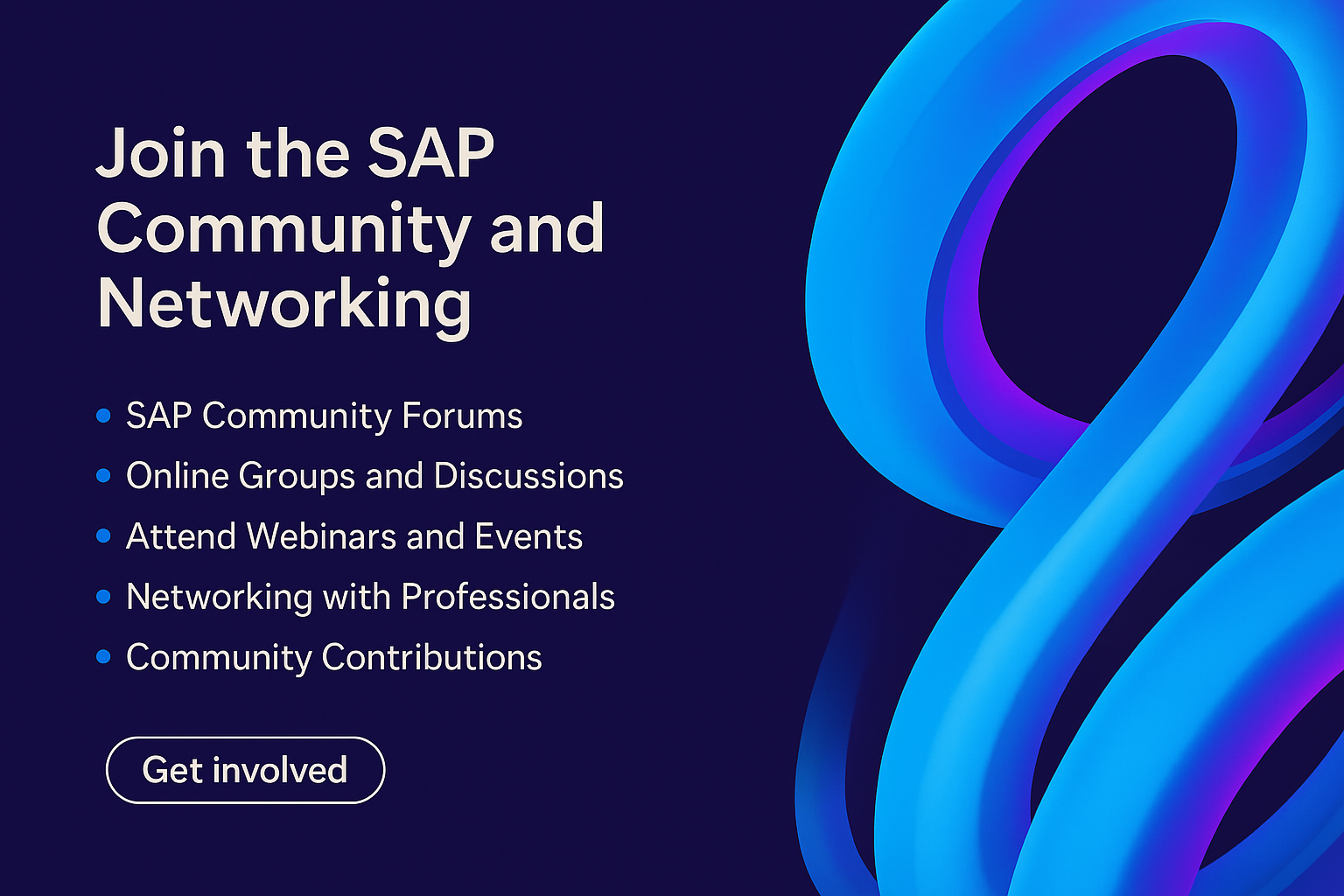
-
SAP Community Forums: The official SAP Community (community.sap.com) has forums for almost every SAP topic. As a learner, you can browse questions asked by others (you’ll often find beginners asking exactly what you want to know), and see answers from experienced consultants. If you encounter a problem or have a question, don’t hesitate to ask there yourself. The community is generally helpful to those who show effort. You might get multiple perspectives on your question, which is very enlightening.
-
Online Groups and Discussions: Platforms like LinkedIn have SAP groups (e.g., “SAP S/4HANA Professionals” or groups for specific modules). Reddit has a subreddit r/SAP where people discuss SAP career advice and technical questions. Being active in these spaces can give you insight into what’s happening in the SAP world in 2025 – like common challenges people face, new job trends, etc.
-
Attend Webinars and Events: SAP and its partners host many webinars, virtual events, and even in-person meetups. For example, the SAP TechEd conference (usually yearly) often has free virtual sessions for learners. There are local SAP user groups (like ASUG in North America, or SAP Inside Track events globally) where professionals share knowledge. Attending these talks or webinars can deepen your understanding and also expose you to real-world case studies of S/4HANA Cloud implementations.
-
Networking with Professionals: Try to connect with SAP professionals on LinkedIn or in person. If someone has the job you aspire to, reach out with a polite note – many people are happy to give tips to newcomers. Joining study groups or find a “buddy” who is also learning SAP can keep you motivated. Networking isn’t just for job hunting; it’s a learning tool. Through conversations, you might learn about which skills are in hot demand or get advice on overcoming a tough learning topic.
-
Community Contributions: As you gain confidence, consider contributing back to the community. Even as a learner, you can write a blog post about your learning journey or how you solved a particular issue – the act of explaining something will reinforce your knowledge. Plus, it gets you noticed in the community.
Remember the old saying: “If you want to go fast, go alone. If you want to go far, go together.” By engaging with the SAP community, you’ll find support when you’re stuck, mentorship from seasoned experts, and camaraderie with fellow learners. It makes the whole process much more enriching.
8. Learn Advanced Concepts and Prepare for Certification/Jobs
By this step, you’re well on your way. The final part of your plan is about polishing your expertise and getting ready to use your skills professionally:

-
Tackle Advanced Topics: There may be advanced concepts or features you haven’t touched yet. For functional folks, this could be things like SAP S/4HANA Cloud Extensibility (how to customize the system without modifying standard code) or deep-dive into analytics (using tools like SAP Analytics Cloud with S/4HANA). For technical learners, you might start exploring SAP BTP (Business Technology Platform), which allows you to build extensions, or advanced ABAP for cloud, or integration tools like SAP Integration Suite. Also, S/4HANA has embedded intelligent technologies (machine learning scenarios, predictive analytics) – these could be fascinating areas to explore once basic stuff is comfortable.
-
Validate Your Skills with Certification (Optional but Beneficial): Earning an SAP certification can bolster your credibility. SAP offers official certifications for various S/4HANA Cloud roles (e.g., “SAP Certified Application Associate – SAP S/4HANA Cloud (public) – Finance Implementation” and similar for other areas). Preparation for certification will ensure you’ve covered all the key topics in your chosen area. Typically, you’ll review the exam guide, revisit any areas you’re weak in, and take practice tests. Many learners spend around 1-2 months on focused study to prepare for an associate-level exam. Certification isn’t mandatory to have a career in SAP, but it’s a respected proof of knowledge – and studying for it can solidify your understanding.
-
Build Your Portfolio/Resume: Start compiling what you’ve done. If you completed a hands-on project (as suggested in step 6), write it down as an experience: e.g., “Simulated an end-to-end Order-to-Cash process in SAP S/4HANA Cloud including configuration of enterprise structure and master data.” If you’ve taken courses, list those. Highlight your skills (modules you know, any tools like Fiori or ABAP, etc.). Employers often look for specific keywords, so make sure to mention the relevant ones (“SAP S/4HANA Cloud”, specific modules like FI, MM, etc., “Fiori”, “SAP Analytics” if applicable, etc.).
-
Job Search and Interviews: When you feel ready, begin looking at entry-level SAP roles or internal opportunities at your company. Be honest about your experience level, but also confident in the skills and knowledge you’ve built. In interviews, emphasize your hands-on practice and your understanding of business processes – companies value the ability to translate business needs into SAP solutions. Even if you haven’t had a formal SAP job yet, your practical projects and certification can demonstrate your capability. You might start in a junior role or as part of a project team, where you can continue to learn on the job.
-
Keep Learning Continuously: The end of the “from scratch” learning plan is really the beginning of your continuous growth. Make it a habit to stay updated (via SAP community blogs, news, etc.). SAP S/4HANA will keep evolving with new features, and as you work on different projects you’ll encounter new challenges. Embrace the mindset that you’ll always be learning – that’s part of what makes a technology career exciting!
Following these steps, you’ll have built a strong foundation and be well-equipped to start a professional journey with SAP S/4HANA Cloud.
Resources to Learn SAP S/4HANA Cloud
As you execute your learning plan, it’s important to leverage quality resources. Here are some of the best resources (in 2025) to learn SAP S/4HANA Cloud, ranging from official courses to community materials:
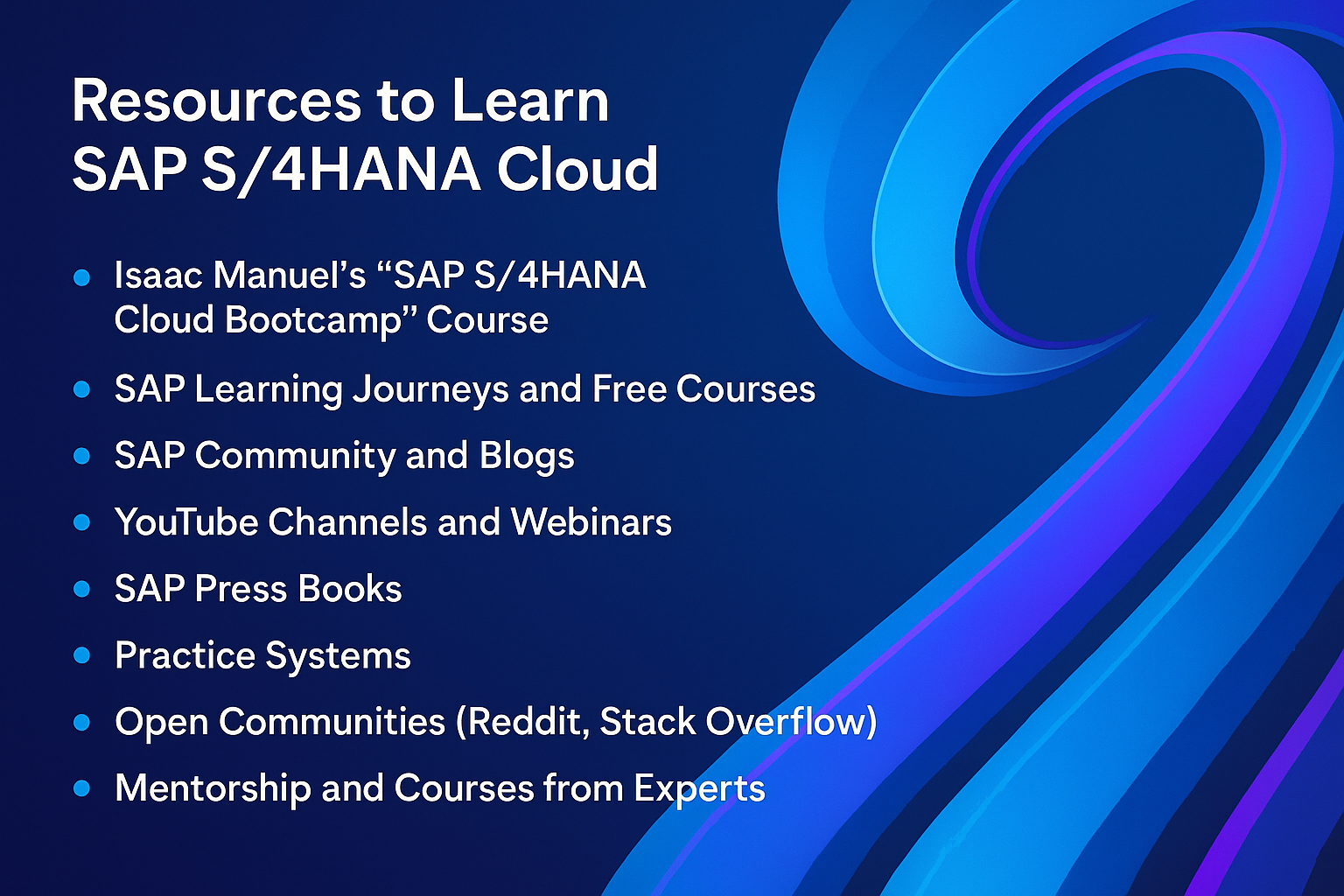
-
Isaac Manuel’s “SAP S/4HANA Cloud Bootcamp” Course: Highly recommended for beginners, this online course is a structured bootcamp that covers SAP and ERP fundamentals, the evolution to S/4HANA, and core S/4HANA Cloud functionalities. It’s beginner-friendly and offers plenty of demonstrations of real business scenarios in S/4HANA Cloud. The course provides a step-by-step guided experience, which is perfect if you’re starting from scratch. (Link: Getting Started with SAP S/4HANA Cloud Course) – This course’s strength is in its hands-on approach: you’ll see actual system demonstrations of processes (like Service Contract Management, Order Management, etc.) and get a structured understanding of each topic, rather than just theory.
-
SAP Learning Journeys and Free Courses: SAP’s official learning platform offers free Learning Journeys for S/4HANA Cloud. These are guided paths containing tutorials, videos, and sometimes interactive exercises. For example, there might be a “Become an SAP S/4HANA Cloud Finance Consultant” journey which starts from basics and goes to intermediate topics. Additionally, many openSAP courses (which were MOOCs) have migrated to the SAP Learning site – you can find courses like “Implementing SAP S/4HANA Cloud Public Edition”, “SAP S/4HANA Cloud Overview”, etc. All of these are taught by SAP experts and often include quizzes and discussions. They’re free – you just need to sign up with an SAP account.
-
SAP Community and Blogs: The SAP Community website is a treasure trove of knowledge. Check out the SAP S/4HANA Cloud topic page there for the latest blog posts, how-to guides, and Q&A. Often, SAP product managers and experienced consultants write “blog posts” explaining new features or best practices in approachable language. You’ll also find community-created tutorials like “How to create custom business objects in S/4HANA Cloud” or “10 Tips for new S/4HANA Cloud users”. Subscribing to the community updates or spending some time each week reading popular posts can greatly supplement your learning.
-
YouTube Channels and Webinars: There are several useful YouTube channels for SAP learning. For instance, SAP’s official YouTube channel often has webinars and short videos on S/4HANA Cloud features. You might find series like “SAP S/4HANA Cloud in 2 Minutes” explaining concepts quickly, or recorded sessions from SAP events. Additionally, some independent SAP trainers and firms have channels – search for terms like “SAP S/4HANA Cloud tutorial” on YouTube and you’ll find many walkthroughs. Just be sure the content is recent (within the last year or two) so it’s relevant to the 2025 version of S/4HANA Cloud.
-
SAP Press Books: If you like structured reading, SAP Press (the official publisher of SAP books) has up-to-date books on S/4HANA. Titles such as “SAP S/4HANA Cloud: An Introduction”, “Implementing SAP S/4HANA Cloud”, or module-specific guides (like “First Steps in Financial Accounting in S/4HANA”). These books are authored by experts and can serve as both learning manuals and reference guides. They often include screenshots and examples. Keep in mind SAP Press books are paid, but many find them worth the investment for deep learning.
-
Practice Systems: While not a “learning content” per se, having access to a practice system is a resource in itself. If your budget allows, consider a subscription to SAP Learning System Access (offered via SAP Learning Hub) which gives you a live S/4HANA instance to play with. Alternatively, explore if SAP offers a developer edition of S/4HANA or any free trials in 2025. Sometimes, SAP’s partner cloud (e.g., SAP Cloud Appliance Library) provides a trial instance for a short duration which you can use to follow along with exercises.
-
Open Communities (Reddit, Stack Overflow): For quick answers and discussions, sites like Reddit (r/SAP or r/S4HANA) and Stack Overflow (tagged with SAP, though more technical) can be helpful. These are unofficial but sometimes you get very straightforward practical advice. Just remember to double-check information from forums, as quality can vary.
-
Mentorship and Courses from Experts: Apart from Isaac Manuel’s course, there are other expert-led courses on platforms like Udemy or Coursera, and some live training from SAP or accredited partners. For example, you might find a Udemy course titled “SAP S/4HANA Cloud for Absolute Beginners (2025 Edition)” – just ensure to read reviews and see if the content is up-to-date. If you prefer live classroom training, SAP Education and various training partners offer intensive bootcamps (though these can be costly). Sometimes, community colleges or universities have extension courses on SAP as well.
Using a combination of these resources will give you both breadth and depth. For instance, you might start with Isaac’s structured course for a solid foundation, use SAP’s free materials to supplement and stay current, read a book for in-depth understanding, and use community forums when you hit specific questions. Everyone’s learning blend is different – the key is to know that resources abound. You just need to dedicate the time to use them.
(Pro tip: When learning, try to apply each new concept you learn in a resource. If a video talks about creating a Purchase Order, pause and go create a Purchase Order in your trial system. This “learn by doing” approach is super effective.)
Final Thoughts
Learning SAP S/4HANA Cloud from scratch in 2025 might seem challenging, but it’s absolutely achievable with the right approach and mindset. Remember that thousands of professionals have made this journey – many starting with no SAP background – and have successfully transitioned into SAP careers. You can do it too!
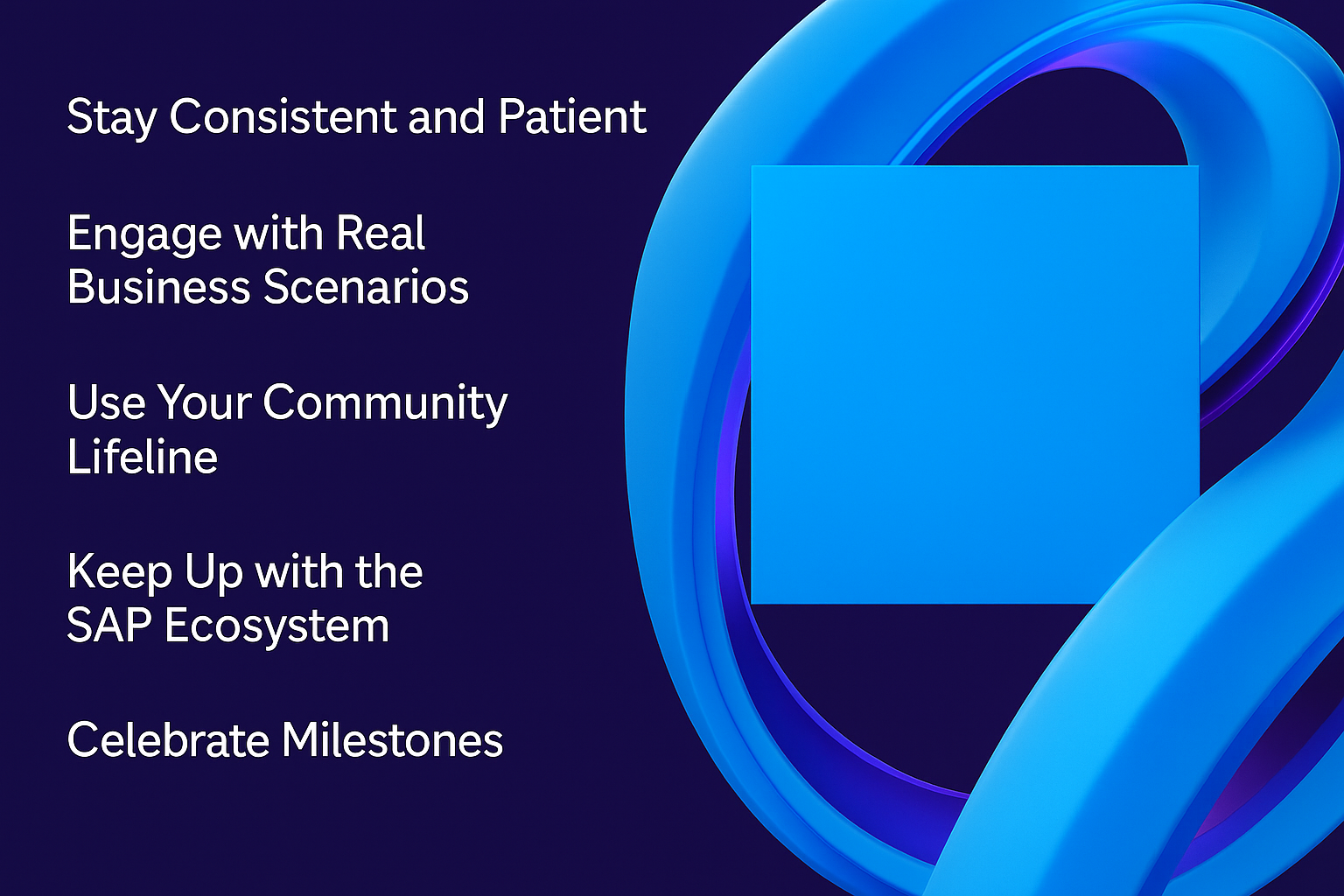
A few parting pieces of advice as you continue on this path:
-
Stay Consistent and Patient: SAP is a vast system; you won’t learn it overnight. Commit to a regular learning schedule, even if it’s a bit each day. Over weeks and months, those hours add up. Be patient with yourself when you encounter complex topics – every expert was once a beginner who felt confused by the same things.
-
Engage with Real Business Scenarios: Always tie your learning back to real business meaning. Ask yourself, “What business problem does this function solve?” This not only helps you remember things better, but it also prepares you to think like an SAP professional who delivers value, not just a person who knows transaction codes. For example, knowing how to execute a transaction is good, but understanding that it’s used to, say, “forecast inventory to prevent stockouts” is even better.
-
Use Your Community Lifeline: Don’t hesitate to seek help. When you get stuck or need guidance, leverage the SAP community and your network. Sometimes a quick tip from an expert can save you hours of frustration. Plus, discussing what you’ve learned or struggling with can spark new insights and keep you motivated.
-
Keep Up with the SAP Ecosystem: The world of SAP in 2025 and beyond will continue to evolve – with extensions, integrations to other cloud services, and new intelligent features. Embrace continuous learning as part of your career. Subscribe to SAP news, follow SAP on social media or blogs, and maybe even get involved in special interest groups (like a local SAP users group). This will ensure your knowledge stays fresh and you can catch new opportunities (for example, perhaps learning about SAP’s moves in AI or sustainability).
-
Celebrate Milestones: Finally, acknowledge your progress. SAP learning is like climbing a mountain – make sure to occasionally turn around and see how far you’ve come! The first time you navigate the system without fear, or when you complete your first solo configuration, or when you get certified – those are huge wins. Celebrate them.
In conclusion, embarking on learning SAP S/4HANA Cloud in 2025 is a wise and forward-looking decision. Businesses around the globe need professionals who understand this powerful platform. With a clear plan, the right resources, and persistent effort, you can become proficient in SAP S/4HANA Cloud from scratch. It’s a journey of continuous discovery, but one that will equip you with valuable skills and open doors to rewarding career opportunities. Good luck, and enjoy the learning process – before you know it, you’ll be leveraging SAP S/4HANA Cloud to drive real business success!

